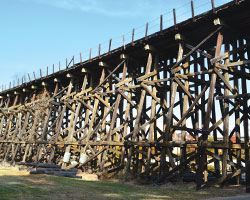

MPC Research Reports |
| Title: | Safety Factor Increase to Fatigue Limit States through Shear Spiking for Timber Railroad Bridge Rehabilitation - Phase I |
| Authors: | Thang Dao and John W. van de Lindt |
| University: | Colorado State University |
| Publication Date: | Nov 2014 |
| Report #: | MPC-14-273 |
| Project #: | MPC-277 |
| TRID #: | 01546186 |
| Keywords: | algorithms, fatigue tests, railroad bridges, rehabilitation (maintenance), safety factors, spikes, wooden bridges |
 The overall project is to demonstrate the effectiveness of shear spiking (technique already developed through a previous project). Many timber railroad bridges are deficient but it is too costly to replace them; hence, inexpensive repair techniques are needed. The proposed project will provide the necessary documentation of the effectiveness of this newly developed mitigation technique under realistic loads using new equipment available from a National Science Foundation grant to Colorado State University. This will ultimately be accomplished through a series of spatio-temporal fatigue tests on stringers for both non-repaired and repaired. The timing and locations of the loading will be determined from influence line analysis of a typical freight train(s). The results will be used as leverage and/or proof-of-concept to approach the American Railway Association for additional funding. This report presents the intermediate results of the project, which is designated herein as Phase I. Phase I focused on development of the actuator control algorithm, which was successfully tested in the Colorado State University Structural Engineering Laboratory in the spatio-temporal test frame using seven actuators simultaneously in force control.
The overall project is to demonstrate the effectiveness of shear spiking (technique already developed through a previous project). Many timber railroad bridges are deficient but it is too costly to replace them; hence, inexpensive repair techniques are needed. The proposed project will provide the necessary documentation of the effectiveness of this newly developed mitigation technique under realistic loads using new equipment available from a National Science Foundation grant to Colorado State University. This will ultimately be accomplished through a series of spatio-temporal fatigue tests on stringers for both non-repaired and repaired. The timing and locations of the loading will be determined from influence line analysis of a typical freight train(s). The results will be used as leverage and/or proof-of-concept to approach the American Railway Association for additional funding. This report presents the intermediate results of the project, which is designated herein as Phase I. Phase I focused on development of the actuator control algorithm, which was successfully tested in the Colorado State University Structural Engineering Laboratory in the spatio-temporal test frame using seven actuators simultaneously in force control.
Dao, Thang, and John W. van de Lindt. Safety Factor Increase to Fatigue Limit States through Shear Spiking for Timber Railroad Bridge Rehabilitation - Phase I, MPC-14-273. North Dakota State University - Upper Great Plains Transportation Institute, Fargo: Mountain-Plains Consortium, 2014.